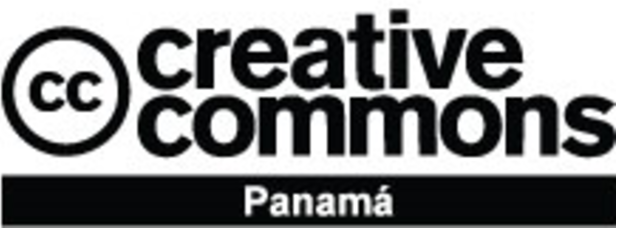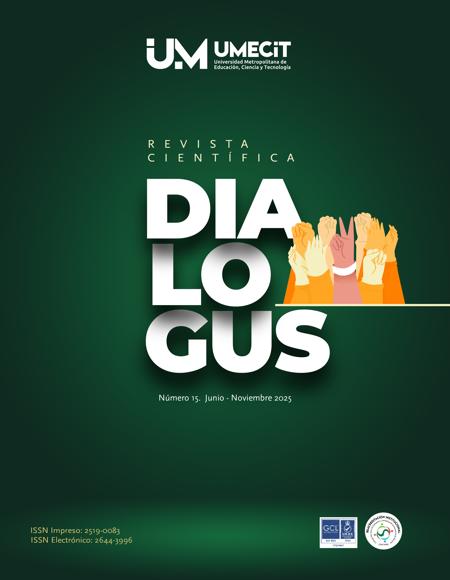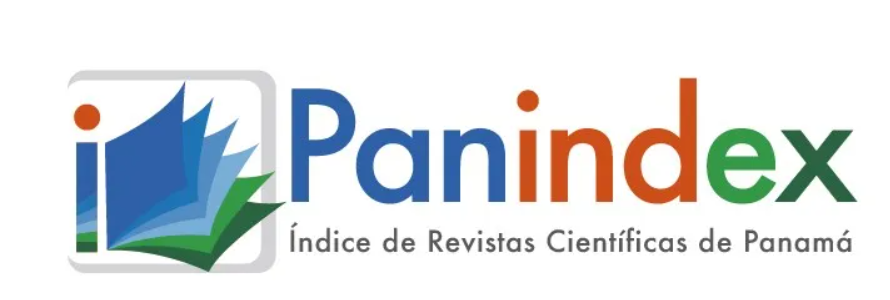The content of the publications and the links suggested in them are the sole responsibility of the authors and not of the METROPOLITAN UNIVERSITY OF EDUCATION, SCIENCE AND TECHNOLOGY (UMECIT) or DIALOGUS magazine. They are protected by international copyright laws as well as the UMECIT and DIALOGUS logos, hence their reproduction is totally prohibited.
This work is licensed under a Creative Commons Attribution-NonCommercial-NoDerivatives 4.0 International License.
The authors maintain the copyright and transfer the right of the first publication to the journal, with the article registered with Creative Commons Attribution-NonCommercial-NoDerivatives License, which allow others They can download the works published in this magazine and share them with other people, as long as their authorship is recognized, but they cannot be changed in any way nor can they be used commercially.
Authors are recommended to include their work in social networks such as Researchgate and institutional repositories once the article or visible fact has been published on the journal page, without forgetting to include the digital document identifier and the name of the journal.



Abstract
Taking technology and evaluation as a reference, this article shows a perspective of the field that includes evaluation at a local and international level, as well as unrestricted access to technological tools that serve as a means to develop and achieve learning objectives, mentioning the fundamental contributions of: Espinoza (2021), Lara et al., (2021), Subauste (2017), Morgan (2013), RLOEI, (2023), Gallego & Cebrián (2018), Cabero & Palacios (2021), Aurioles (2021), (Carmona & Puertas, 2012), (Delgado, 2019), which allowed to give reliability to the present work, since they describe the theme explicitly. On the other hand, a bibliographic documentary review was carried out from the methodological point of view, which allows the collection and analysis of information through the existing scientific literature. It should be noted that technology in assessment is a planned methodological process, whose objective is to increase the student's learning achievement and the teacher's technological skills, taking into account the availability of freely accessible tools and applications. Therefore, the use of technology in the evaluation is imperative, since it allows solving factors such as: the development of an instrument that complies with the standards of the evaluation process, and that the process in question becomes a digital space in which which students are motivated by the interactive use of technology. In conclusion, technological ubiquity, applied to evaluation, provides significant benefits for the teacher, as well as for the student, allowing innovation in the educational and evaluative moment.
Keywords
References
Barberá, E. (2016). Aportaciones de la tecnología a la e-Evaluación. Revista de Educación a distancia (RED), (50).
Bizarro, W., Sucari, W., & Quispe-Coaquira, A. (2019). Evaluación formativa en el marco del enfoque por competencias. Revista Innova Educación, 1(3), 374-390.
Cabero Almenara, J., & Palacios Rodríguez, A. D. P. (2021). La evaluación de la educación virtual: las e-actividades. RIED. Revista Iberoamericana de Educación a Distancia.
Cáceres Mesa, M. L., Pérez Maya, C. J., & Callado Pérez, J. (2019). El papel de la evaluación del aprendizaje en la renovación de los procesos de enseñanza y aprendizaje. Conrado, 15(66), 38-44.
Cámara, G. (2008). Otra educación básica es posible: Siglo XXI.
Carmona, L., & Puertas, F. (2012). U-Learning: La revolución del aprendizaje. Recuperado el, 2.
Cazan, A. M., & Maican, C. I. (2023). Factores determinantes en el uso del e-learning y la satisfacción docente. Comunicar: Revista científica iberoamericana de comunicación y educación, (74), 89-100.
Delgado, R. Z. (2019). El m-learning, las ventajas de la utilización de dispositivos móviles en el proceso autónomo de aprendizaje. ReHuSo: Revista de Ciencias Humanísticas y Sociales, 4(3), 29-38.
Espinoza Freire, E. E. (2021). Importancia de la retroalimentación formativa en el proceso de enseñanza-aprendizaje. Revista Universidad y Sociedad, 13(4), 389-397.
Flores Ortiz, Á., & García Martínezi, A. (2017). Sistema de aprendizaje ubicuo en ambientes virtuales. Revista Cubana de Educación Superior, 36(2), 27-40.
Gallego-Arrufat, M. J., & Cebrián-de-la-Serna, M. (2018). Contribuciones de las tecnologías para la evaluación formativa en el prácticum. Profesorado, Revista de Currículum y Formación del Profesorado, 22(3), 139-161.
García Jiménez, E. (2015). La evaluación del aprendizaje: de la retroalimentación a la autorregulación. El papel de las tecnologías.
García-Ruiz, R., Bonilla-del-Río, M., & Diego-Mantecón, J. M. (2018). Gamificación en la Escuela 2.0: una alianza educativa entre juego y aprendizaje. Gamificación en Iberoamérica, 71-95.
García, M. L. S., Flores, M. D. P. G., Cano, E. V., & Yedra, L. R. (2016). Ubicuidad y movilidad de herramientas virtuales abren nuevas expectativas formativas para el estudiantado universitario. Revista Ensayos Pedagógicos, 11(2), 99-131.
Hernández-Vicente, P. O. (2023). Los recursos tecnológicos y la educación. Con-Ciencia Serrana Boletín Científico de la Escuela Preparatoria Ixtlahuaco, 5(9), 16-18.
Lara, K. L. T., Párraga, J. F. M., Barona, V. B. G., & Larenas, F. P. (2021). Técnicas e Instrumentos de Evaluación como Herramienta para el Cumplimiento de los Resultados de Aprendizaje. Polo del Conocimiento: Revista científico-profesional, 6(12), 32.
Montes Iturrizaga, I. (2007). Estándares de aprendizaje. Definición, tensiones y propuesta para el Perú.
Morgan, C. (2013). Construyendo el programa para la evaluación internacional de estudiantes de la OCDE (PISA). Profesorado. Revista de Currículum y Formación de Profesorado, 17(2), 31-45.
Pallasco-Barros, N. J., Guaña-Moya, E. J., & Arteaga-Alcívar, Y. A. (2022). Las Tecnologías de la Información y Comunicación en aplicaciones U-learning. Revista Científica FIPCAEC (Fomento de la investigación y publicación científico-técnica multidisciplinaria). ISSN: 2588-090X. Polo de Capacitación, Investigación y Publicación (POCAIP), 7(2), 200-216.
Ramírez Sepúlveda, P. (2019). La evaluación para el aprendizaje desde la articulación entre Segundo Nivel de Transición de Educación Parvularia y Primer Año de Educación Básica.
Reyes Carreto, R., Godínez Jaimes, F., Ariza Hernández, F. J., Sánchez Rosas, F., & Torreblanca Ignacio, O. F. (2014). Un modelo empírico para explicar el desempeño académico de estudiantes de bachillerato. Perfiles educativos, 36(146), 45-62.
RLOEI. (2023). REGLAMENTO GENERAL A LA LEY ORGÁNICA DE EDUCACIÓN INTERCULTURAL 1 – 124
Sánchez, Z. C. N. (2018). El e-learning como un recurso de desarrollo educativo. Aibi revista de investigación, administración e ingeniería, 6(2), 1-1.
Schleicher, A. (2006). Fundamentos y cuestiones políticas subyacentes al desarrollo de PISA. Revista de Educación.
Subauste Bolivar, M. G. (2017). Técnicas e instrumentos de evaluación del proceso de enseñanza y aprendizaje.
Torres Vásquez, A., & San Martín Cantero, D. (2021). Utilidad de la retroalimentación en estudiantes de pedagogía de educación especial. Revista de estudios y experiencias en educación, 20(43), 249-265.
Véliz, C. M. M., & Páez-Quinde, C. (2022). APLICACIONES MÓVILES EN LA EDUCACIÓN 4.0 DE LOS ESTUDIANTES DE BACHILLERATO GENERAL UNIFICADO DEL CANTÓN SAN CRISTÓBAL–GALÁPAGOS. AULA VIRTUAL, 3(8), 26-39.
Downloads
Publication Facts
Reviewer profiles N/A
Author statements
- Academic society
- Universidad Metropolitana de Educación, Ciencia y Tecnología
- Publisher
- Universidad Metropolitana de Educación, Ciencia y Tecnología




















